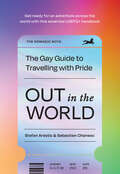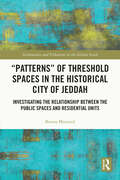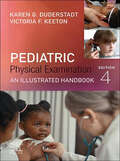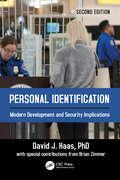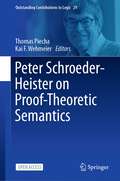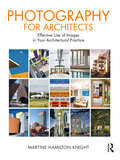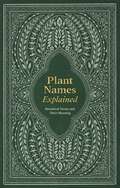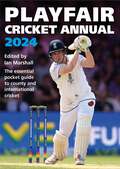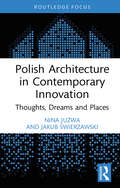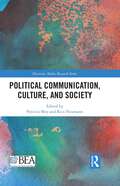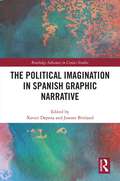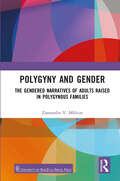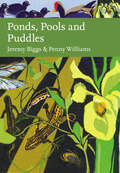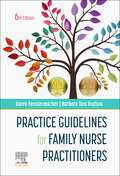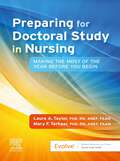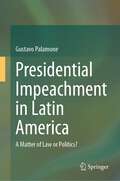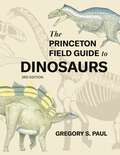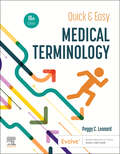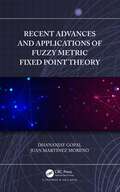- Table View
- List View
Out in the World: The Gay Guide to Travelling with Pride
by null Stefan Arestis null Sebastien ChaneacOut in the World is THE indispensable guide to LGBTQ+ travel from The Nomadic Boys – full of tips, advice and resources on the best and safest places to visit around the world. Get ready for a fabulous adventure across the world with this essential guide to LGBTQ+ travel. The Nomadic Boys share their favourite travel experiences spanning six continents in gorgeous technicolour, giving you tips, advice and resources for making the most of every destination. Plan your own trip of a lifetime, exploring the world's most dazzling Pride celebrations whilst discovering top-notch spots for great food and drink. From must-see landmarks to hidden gems – whether you dream of snorkelling in the Philippines, skiing in Canada, stargazing in New Zealand or partying in the streets of Mexico – this is your ticket to travel with pride! - Travel with confidence - Connect with local LGBTQ+ communities - Find practical tips for travelling safely - Make the most of every destination
“Patterns” of Threshold Spaces in the Historical City of Jeddah: Investigating the Relationship Between the Public Spaces and Residential Units (Architecture and Urbanism in the Global South)
by Basma Massoud“Patterns” of Threshold Spaces in the Historical City of Jeddah explores the meaning of threshold spaces and investigates the relationship between the public spaces and residential units in the historical city of Jeddah, Saudi Arabia, while at the same time revisiting Christopher Alexander’s theory in his canonical 1977 book, A Pattern Language. This book questions and analyses “patterns” relating to the cultural, social, and environmental particularities of Jeddah, with special attention paid to the effect of gender segregation in the city’s urban configuration. It discusses the extension that has been undertaken through testing a concept from the urban design theory of the West (the United States and Canada) and applying it to an Islamic city to find patterns in four different scales, which form the basis of the investigation (body, building, street, and city). Empirical methods have been used in the context of historical Jeddah, through which patterns are investigated using different approaches for the different scales. The book aims to explore the meaning of threshold spaces in old Jeddah. Furthermore, it shows that there are eighteen patterns of threshold spaces in the old town: patterns that are solely related to this specific case study, as well as modified patterns to the ones explored by Christopher Alexander. This book shall allow not only a better understanding of the relationship between housing and the historical city but also an exploration of the role of the threshold space in shaping the old city of Jeddah. It will be of interest to researchers, students of architecture, urban planning and anthropology studies, and people involved in cultural heritage, both academics and practitioners.
“Patterns” of Threshold Spaces in the Historical City of Jeddah: Investigating the Relationship Between the Public Spaces and Residential Units (Architecture and Urbanism in the Global South)
by Basma Massoud“Patterns” of Threshold Spaces in the Historical City of Jeddah explores the meaning of threshold spaces and investigates the relationship between the public spaces and residential units in the historical city of Jeddah, Saudi Arabia, while at the same time revisiting Christopher Alexander’s theory in his canonical 1977 book, A Pattern Language. This book questions and analyses “patterns” relating to the cultural, social, and environmental particularities of Jeddah, with special attention paid to the effect of gender segregation in the city’s urban configuration. It discusses the extension that has been undertaken through testing a concept from the urban design theory of the West (the United States and Canada) and applying it to an Islamic city to find patterns in four different scales, which form the basis of the investigation (body, building, street, and city). Empirical methods have been used in the context of historical Jeddah, through which patterns are investigated using different approaches for the different scales. The book aims to explore the meaning of threshold spaces in old Jeddah. Furthermore, it shows that there are eighteen patterns of threshold spaces in the old town: patterns that are solely related to this specific case study, as well as modified patterns to the ones explored by Christopher Alexander. This book shall allow not only a better understanding of the relationship between housing and the historical city but also an exploration of the role of the threshold space in shaping the old city of Jeddah. It will be of interest to researchers, students of architecture, urban planning and anthropology studies, and people involved in cultural heritage, both academics and practitioners.
Pediatric Physical Examination - E-Book: Pediatric Physical Examination - E-Book
by Karen G. Duderstadt Victoria F. KeetonKnown for its accuracy, consistency, and portability, Pediatric Physical Examination: An Illustrated Handbook, 4th Edition teaches the unique range of skills that Nurse Practitioners and primary care providers need to assess children of all ages. Spiral-bound for quick reference in clinical settings, this photo-rich, step-by-step guide to physical examination prepares you to expertly examine children from birth through adolescence. Body system chapters begin with fetal development and take you through the key developmental stages of childhood. This edition features new sections with Telehealth Tips and Considerations for Special Populations in many chapters, as well as expanded coverage of maltreatment, mental health, and social disparities of health.Expert guidance for the pediatric physical exam employs the "quiet-to-active" approach, starting with the listening parts of the physical exam and moving on to the hands-on components, the physical assessment approach that yields the best results in the pediatric age group. Quick-reference features include special tables/boxes, such as Information Gathering, Conditions, Pediatric Pearls, Red Flags, Interprofessional Collaboration Notes, Evidence-Based Practice, and EHR Documentation.Easy-to-use layout provides quick access to concise guidance for the pediatric physical exam.Richly illustrated, full-color format facilitates readability and learning with more than 300 photos and line drawings of assessment techniques and common assessment findings.Inclusive and ethnically diverse illustrations better represent the diverse populations pediatric health care providers work with every day.NEW! Telehealth Tips section added to chapters reflects the greatly expanded use of telehealth visits in clinical practice.NEW! Information on maltreatment, mental and behavioral health, and social determinants of health explored throughout the chapters.NEW! Considerations for special needs populations added to most chapters.NEW! Guidance on use of screen time for early childhood and advice for families.
Personal Identification: Modern Development and Security Implications
by David J. HaasPersonal Identification: Modern Development and Security Implications, Second Edition explains how personal identification – and REAL ID – became part of the American fabric along with their past century’s historical ID development. The development of the “trusted and secure” personal identification documents began with passports and has continued as social changes made IDs more essential. This book describes the convergence of technologies and hundreds of patents that produced our “trusted and secure” documents and IDs from our past right up through to today.Key factors, that created today’s need for public-issued mass ID, are addressed: Chronicles the effects of large and mobile populations beginning a century ago Chronicles the effects of “impersonal” electronic & computer communications at a distance, and not face-to-face The distribution of services and money by government agencies based on a person’s identity – including “age” and “group” criteria Describes recent national security and terrorism concerns that necessitates the need to know: “You are who you say you are.” Personal identification documents (IDs) and the societal need for “trusted” identification by the public is a relatively new social phenomenon. In 1900, most people did not need or have any IDs until passports, with a photograph of the individual, became mandatory when Great Britain entered World War I in 1914. In the United States, the State-issued driver’s license is probably the only trusted ID in one’s wallet today, but they became “trusted and secure” documents only recently with the requirement for REAL ID. With the first photo driver’s license issued by the State of Colorado in 1959, it took until 1984 for the last State (New York, 25 years later) to comply.As a direct result of 9/11, where terrorists used fake driver’s licenses to board planes, Congress passed the Real ID Act in 2005 to make all State-issued driver’s licenses more trusted, uniform, and tamper-resistant – what is now called the Enhanced Driver’s License with non-drivers being issued Enhanced Identification Cards. And with this, every US citizen can now possess a trusted and secure personal identification document.Personal Identification, Second Edition chronicles the path of personal identification measures – including the latest developments of Real ID. Scholars and professional security managers understand that stability, security, and safety necessitate these identity measures to ensure a safer America. The book explains the various stages and advances, providing readers with a unique study of this fascinating history of the relationship between identity and the means by which one validates and proves their own identity. The enactment of the REAL ID Act of 2005, with more secure and tamper-resistant documents for each citizen of the United States, is being instituted so that one can trust: “you are who you say you are.” The State-issued driver’s license is not a National ID Card – it is a Nationally Recognized ID for each citizen.
Personal Identification: Modern Development and Security Implications
by David J. HaasPersonal Identification: Modern Development and Security Implications, Second Edition explains how personal identification – and REAL ID – became part of the American fabric along with their past century’s historical ID development. The development of the “trusted and secure” personal identification documents began with passports and has continued as social changes made IDs more essential. This book describes the convergence of technologies and hundreds of patents that produced our “trusted and secure” documents and IDs from our past right up through to today.Key factors, that created today’s need for public-issued mass ID, are addressed: Chronicles the effects of large and mobile populations beginning a century ago Chronicles the effects of “impersonal” electronic & computer communications at a distance, and not face-to-face The distribution of services and money by government agencies based on a person’s identity – including “age” and “group” criteria Describes recent national security and terrorism concerns that necessitates the need to know: “You are who you say you are.” Personal identification documents (IDs) and the societal need for “trusted” identification by the public is a relatively new social phenomenon. In 1900, most people did not need or have any IDs until passports, with a photograph of the individual, became mandatory when Great Britain entered World War I in 1914. In the United States, the State-issued driver’s license is probably the only trusted ID in one’s wallet today, but they became “trusted and secure” documents only recently with the requirement for REAL ID. With the first photo driver’s license issued by the State of Colorado in 1959, it took until 1984 for the last State (New York, 25 years later) to comply.As a direct result of 9/11, where terrorists used fake driver’s licenses to board planes, Congress passed the Real ID Act in 2005 to make all State-issued driver’s licenses more trusted, uniform, and tamper-resistant – what is now called the Enhanced Driver’s License with non-drivers being issued Enhanced Identification Cards. And with this, every US citizen can now possess a trusted and secure personal identification document.Personal Identification, Second Edition chronicles the path of personal identification measures – including the latest developments of Real ID. Scholars and professional security managers understand that stability, security, and safety necessitate these identity measures to ensure a safer America. The book explains the various stages and advances, providing readers with a unique study of this fascinating history of the relationship between identity and the means by which one validates and proves their own identity. The enactment of the REAL ID Act of 2005, with more secure and tamper-resistant documents for each citizen of the United States, is being instituted so that one can trust: “you are who you say you are.” The State-issued driver’s license is not a National ID Card – it is a Nationally Recognized ID for each citizen.
Peter Schroeder-Heister on Proof-Theoretic Semantics (Outstanding Contributions to Logic #29)
This open access book is a superb collection of some fifteen chapters inspired by Schroeder-Heister's groundbreaking work, written by leading experts in the field, plus an extensive autobiography and comments on the various contributions by Schroeder-Heister himself. For several decades, Peter Schroeder-Heister has been a central figure in proof-theoretic semantics, a field of study situated at the interface of logic, theoretical computer science, natural-language semantics, and the philosophy of language. The chapters of which this book is composed discuss the subject from a rich variety of angles, including the history of logic, the proper interpretation of logical validity, natural deduction rules, the notions of harmony and of synonymy, the structure of proofs, the logical status of equality, intentional phenomena, and the proof theory of second-order arithmetic. All chapters relate directly to questions that have driven Schroeder-Heister's own research agenda and to which he has made seminal contributions. The extensive autobiographical chapter not only provides a fascinating overview of Schroeder-Heister's career and the evolution of his academic interests but also constitutes a contribution to the recent history of logic in its own right, painting an intriguing picture of the philosophical, logical, and mathematical institutional landscape in Germany and elsewhere since the early 1970s. The papers collected in this book are illuminatingly put into a unified perspective by Schroeder-Heister's comments at the end of the book. Both graduate students and established researchers in the field will find this book an excellent resource for future work in proof-theoretic semantics and related areas.
Photography for Architects: Effective Use of Images in Your Architectural Practice
by Martine Hamilton Knight***Shortlisted for the Architectural Book Awards 2024***We live in a world driven by images, but with so much visual noise, is anyone really looking? How does an architect ensure their portfolio is within view of the right audience? Photographs are still as vital to architectural practice as they ever were. However, creation and circulation, once in the hands of skilled professionals, is now perceived as being ‘free’ and within easy reach of all. But where is the clarity? What is the message? By setting out the case for curated image making, considered photography may again be placed at the centre of architectural marketing strategies.Photography for Architects guides the reader through various topics: from establishing a visual brand and sharing images online, to producing content in-house and commissioning professionals. It explores the still and moving image, creating books and exhibitions for legacy value, compiling award entries, and engaging with trade press. Little understood aspects regarding legal rights and obligations, ethics, copyright, and licensing images for use are discussed in clear language. Multiple photographic examples and conversations with international practitioners highlight the various themes throughout.Written by a working architectural photographer whose life has been spent in commercial practice, this easy-to-read, richly illustrated guide is essential reading for architects and designers alike who are working with images and image makers.
Plant Names Explained: Botanical Terms and Their Meaning
by Editors of Editors of David & CharlesIf you, like many gardeners, have a fascination for plant names and their derivations, but stop short of wanting to study botanical nomenclature in great depth, this book is for you!Precise naming is essential to be able to identify plants accurately and most gardeners have at least some knowledge of ‘botanical Latin’. But a plant’s full botanical name does much more than give it a unique label. The name can often tell you where the plant originated, who discovered it, what shape it is, and much else besides. What’s more, the name can be used and understood anywhere in the world.This is a book to have with you at the garden centre, and one to keep beside your bed for an entertaining read. Plant Names Explained is an indispensable guide and makes the subject accessible, enjoyable and fun. It shows not only how plant names work, but also how you can make use of them in entertaining as well as practical ways.A selective alphabetical listing of botanical names and their explanations is accompanied by features exploring cultivar names, with translations of foreign terms and lists of plants you can link with special occasions and celebrations, or with personal names. Other features highlight the places, people and plant characteristics that lie behind the names: gardens and nurseries, countries and cities, plant hunters and gardeners, colours, characteristics and habitats.Plant Names Explained is an essential and fascinating guide to the subject. What may at first seem a dry but necessary convention is revealed to be a way of opening up the intriguing world of plants.
Playfair Cricket Annual 2024
by Ian MarshallThe indispensable pocket guide to the cricket season.The 77th edition of the Playfair Cricket Annual is packed with all the information you need to follow the cricket season in 2024, as well as a review of events during the previous twelve months.Pakistan, West Indies, Sri Lanka and Australia will all be touring England this coming summer, and here you'll find comprehensive Test match and limited-overs records and career records to help you follow the action.County cricket is covered in unrivalled depth, with biographies of all players registered to the counties at the start of the season, full coverage of last summer's events and a fixture list for all major domestic matches in 2024.There are also sections on women's cricket and the major domestic T20 competitions from around the world, including The Hundred.For any cricket fan, the season is never complete without a copy of Playfair to guide you through it all.
Polish Architecture in Contemporary Innovation: Thoughts, Dreams and Places
by Nina Juzwa Jakub ŚwierzawskiAuthored by two architects, Polish Architecture in Contemporary Innovation: Thoughts, Dreams and Places tells a story of buildings that were built in Poland between 1980 and 2020, as architecture developed in the Western world and Japan. Its main focus is public utility buildings which the authors “have touched” in situ and which have moved them or sparked their interest. The book is divided into three parts: • Part I focuses on the problem of creating and shaping architectural form and uses examples of both international and Polish architecture. In this section, the authors pose the question: why is the Pritzker Prize so important? • Part II attempts to answer the question of how architecture can change the image of a place. The answer consists of mainly Polish examples of user-friendly architecture, value, and beauty in architecture and place. • Part III analyses buildings that were created in contemporary Poland. Examples are listed in groups, according to their function, pointing out forms that were inspired by the culture of the region, the historical culture of the place, or those which are a new quality and are the foundation of the creation of a place. This book aims to demonstrate Polish architectural solutions in the context of contemporary trends in the West, traditionally seen as more technically and technologically developed countries. The floor plans and sections of the buildings presented in the book show the beauty of geometric and formal solutions and give a new and rare perspective on the latest changes in modern Polish architecture. This book will be of interest to architects as well as researchers and students of contemporary Polish architecture and culture and its place in the European and international context. The Polish edition of this book, published in 2021 by the National Institute of Architecture and Urban Planning in Warsaw, received the Vitruvius Prize 2022 by the Architecture and Urban Planning Committee of the Polish Academy of Sciences.
Polish Architecture in Contemporary Innovation: Thoughts, Dreams and Places
by Nina Juzwa Jakub ŚwierzawskiAuthored by two architects, Polish Architecture in Contemporary Innovation: Thoughts, Dreams and Places tells a story of buildings that were built in Poland between 1980 and 2020, as architecture developed in the Western world and Japan. Its main focus is public utility buildings which the authors “have touched” in situ and which have moved them or sparked their interest. The book is divided into three parts: • Part I focuses on the problem of creating and shaping architectural form and uses examples of both international and Polish architecture. In this section, the authors pose the question: why is the Pritzker Prize so important? • Part II attempts to answer the question of how architecture can change the image of a place. The answer consists of mainly Polish examples of user-friendly architecture, value, and beauty in architecture and place. • Part III analyses buildings that were created in contemporary Poland. Examples are listed in groups, according to their function, pointing out forms that were inspired by the culture of the region, the historical culture of the place, or those which are a new quality and are the foundation of the creation of a place. This book aims to demonstrate Polish architectural solutions in the context of contemporary trends in the West, traditionally seen as more technically and technologically developed countries. The floor plans and sections of the buildings presented in the book show the beauty of geometric and formal solutions and give a new and rare perspective on the latest changes in modern Polish architecture. This book will be of interest to architects as well as researchers and students of contemporary Polish architecture and culture and its place in the European and international context. The Polish edition of this book, published in 2021 by the National Institute of Architecture and Urban Planning in Warsaw, received the Vitruvius Prize 2022 by the Architecture and Urban Planning Committee of the Polish Academy of Sciences.
Political Communication, Culture, and Society (ISSN)
As an installment of Routledge’s Broadcast Education Association (BEA) Electronic Media Research Series, Political Communication, Culture, and Society focuses on the expansive concept of political communication and illuminates the processes, contents, and effects related to myriad forms and vehicles of political communication. Whether involving traditional print or broadcast media, social media platforms, or face-to-face discussions, political communication today has shaped how we perceive others and understand the world around us, including our place in it, and ultimately, how we engage with others as social, cultural, and political beings.Hailing from multiple locations and drawing on a multitude of theories as well as quantitative and qualitative methodologies, the volume’s contributors examine how communication intersects with politics in a broad swath of contexts, ranging from climate change to migration to the notion of political correctness. Collectively they ask and answer questions about how today’s richly textured media ecology shapes our political world and how political messages can fuel – and ameliorate – the issues that deeply cleave societies around the globe.Relevant to scholars and students of journalism, media studies, and communication sciences, this volume will help interested readers better understand today’s increasingly complex sociocultural world through the lens of political communication.
Political Communication, Culture, and Society (ISSN)
by Patricia Moy Rico NeumannAs an installment of Routledge’s Broadcast Education Association (BEA) Electronic Media Research Series, Political Communication, Culture, and Society focuses on the expansive concept of political communication and illuminates the processes, contents, and effects related to myriad forms and vehicles of political communication. Whether involving traditional print or broadcast media, social media platforms, or face-to-face discussions, political communication today has shaped how we perceive others and understand the world around us, including our place in it, and ultimately, how we engage with others as social, cultural, and political beings.Hailing from multiple locations and drawing on a multitude of theories as well as quantitative and qualitative methodologies, the volume’s contributors examine how communication intersects with politics in a broad swath of contexts, ranging from climate change to migration to the notion of political correctness. Collectively they ask and answer questions about how today’s richly textured media ecology shapes our political world and how political messages can fuel – and ameliorate – the issues that deeply cleave societies around the globe.Relevant to scholars and students of journalism, media studies, and communication sciences, this volume will help interested readers better understand today’s increasingly complex sociocultural world through the lens of political communication.
The Political Imagination in Spanish Graphic Narrative (Routledge Advances in Comics Studies)
by Xavier Dapena Joanne BritlandIn a spirit of community and collective action, this volume offers insights into the complexity of the political imagination and its cultural scope within Spanish graphic narrative through the lens of global political and social movements. Developed during the critical years of the COVID-19 pandemic and global lockdown, the volume and its chapters reflect the interdisciplinary nature of the comic. They employ a cultural studies approach with different theoretical frameworks ranging from debates within comics studies, film and media theory, postcolonialism, feminism, economics, multimodality, aging, aesthetics, memory studies, food studies, and sound studies, among others. Scholars and students working in these areas will find the book to be an insightful and impactful resource.
The Political Imagination in Spanish Graphic Narrative (Routledge Advances in Comics Studies)
by Xavier Dapena Joanne BritlandIn a spirit of community and collective action, this volume offers insights into the complexity of the political imagination and its cultural scope within Spanish graphic narrative through the lens of global political and social movements. Developed during the critical years of the COVID-19 pandemic and global lockdown, the volume and its chapters reflect the interdisciplinary nature of the comic. They employ a cultural studies approach with different theoretical frameworks ranging from debates within comics studies, film and media theory, postcolonialism, feminism, economics, multimodality, aging, aesthetics, memory studies, food studies, and sound studies, among others. Scholars and students working in these areas will find the book to be an insightful and impactful resource.
Polygyny and Gender: The Gendered Narratives of Adults Raised in Polygynous Families
by Zamambo V. MkhizeThe people of Africa have contrasting perspectives on gender, feminism, and the family from their Western counterparts. Similarly, social structures like, religion, capitalism and the law require a context-specific application to polygyny. This book examines the construction of gender identity in adults raised in Zulu polygynous families in the Hammarsdale area in KwaZulu-Natal, South Africa. It highlights the complexities of gender identities as participants negotiate between modern, constitutional, and individual freedoms and patriarchal, cultural, and communal customs and traditions. The themes also point towards the argument between individuality and collectivism in the creation of gender identity within polygynous families in Zulu culture. The South African Constitution guarantees gender equality and individual rights and freedoms for its citizens, yet customary law practices, like polygyny, appear to contravene these principles. The participants reveal that although women and men experience different consequences, they cite similar prevalent factors like gender role socialisation, naming practices and the doctrine of seniority, influencing their gender identity construction. Print edition not for sale in Sub Saharan Africa.
Polygyny and Gender: The Gendered Narratives of Adults Raised in Polygynous Families
by Zamambo V. MkhizeThe people of Africa have contrasting perspectives on gender, feminism, and the family from their Western counterparts. Similarly, social structures like, religion, capitalism and the law require a context-specific application to polygyny. This book examines the construction of gender identity in adults raised in Zulu polygynous families in the Hammarsdale area in KwaZulu-Natal, South Africa. It highlights the complexities of gender identities as participants negotiate between modern, constitutional, and individual freedoms and patriarchal, cultural, and communal customs and traditions. The themes also point towards the argument between individuality and collectivism in the creation of gender identity within polygynous families in Zulu culture. The South African Constitution guarantees gender equality and individual rights and freedoms for its citizens, yet customary law practices, like polygyny, appear to contravene these principles. The participants reveal that although women and men experience different consequences, they cite similar prevalent factors like gender role socialisation, naming practices and the doctrine of seniority, influencing their gender identity construction. Print edition not for sale in Sub Saharan Africa.
Ponds, Pools and Puddles (Collins New Naturalist Library)
by Jeremy Biggs Penny WilliamsPonds and pools are a common feature of our landscape – there are at least ten times as many ponds as lakes in the UK – and they are also important wildlife habitats. This book provides a comprehensive and detailed account of these freshwater habitats.
Practice Guidelines for Family Nurse Practitioners - E-Book: Practice Guidelines for Family Nurse Practitioners - E-Book
by Karen Fenstermacher Barbara Toni HudsonThe latest evidence-based guidelines keep you up to date for FNP practice! With updated content and full-color illustrations, Practice Guidelines for Family Nurse Practitioners, 6th Edition provides essential information on the most current national and international guidelines and evidence-based protocols for primary care patients of all ages. Key details are easy to find with the book’s full-color format, concise outline-style guidelines, and abundant summary tables and charts. In addition to coverage of the most common conditions seen in outpatient settings, this edition includes the latest information on topics such as COVID-19 and STDs. Plus, the popular Practice Pearls boxes have been expanded throughout the book. Current, evidence-based guidelines for patients of all ages provide the latest guidance for managing disorders commonly seen by FNPs in primary care settings. Concise outline format makes it easy to quickly locate essential information. Quick-reference tables and charts include pediatric conditions charts, comparative charts for similar disorders, and health maintenance guidelines charts. Need-to-know coverage of the most common disorders helps familiarize practitioners with situations frequently encountered in clinical practice. Content highlights include "not-to-be-missed" content, non-urgent/non-emergent interprofessional referrals, and urgent/emergent interprofessional referrals. Practice Pearls highlight practical clinical wisdom gleaned from the authors’ extensive practice knowledge base. NEW! Updated content reflects the most common conditions and the latest national and international guidelines and evidence-based protocols, including guidelines for COVID-19 and new CDC guidelines for STDs. NEW! Full-color illustrations and design with high-visibility Not-to-be-Missed points and referral information aid learning and comprehension. NEW! Expanded Practice Pearls emphasize the variety in appearance of certain findings depending on skin tone. NEW! Combined cardiac and vascular chapters make information more intuitive and easier to reference. NEW! Expanded dermatology content reflects conditions commonly seen in family practice. NEW! Topics and conditions presented in alphabetical order within each chapter improve reference value, and a new alphabetical list of conditions is located on the inside the front cover of the print edition. NEW! Focused physical examinations are integrated into each body systems chapter as appropriate. NEW! Two additional appendices provide quick access to an acetaminophen dosing chart and an ibuprofen dosing chart.
Preparing for Doctoral Study in Nursing - E-Book: Preparing for Doctoral Study in Nursing - E-Book
by Laura A. Taylor Mary F. TerhaarAre you ready to take your nursing career to the next level? Preparing for Doctoral Study in Nursing: Making the Most of the Year Before You Begin helps you make an informed decision about entering doctoral studies and choosing the nursing credential that helps you reach your career goals. Noted educators and doctoral mentors Laura A. Taylor and Mary F. Terhaar — along with a team of nursing leaders and scholars — describe the big picture for nurses educated at the highest level of scholarship, including the rising demand for advanced practice nurses and the future of nursing. The first and only comprehensive guide to preparing for a doctorate in nursing, this book helps you choose your path, make your decision, and develop a plan for success in doctoral study. Grounded in more than a decade of experience in preparing nurses for doctoral study, this one-of-a-kind text is the first comprehensive guide to the year before you apply. Fifteen chapters provide practical information and guidance to help you navigate the challenges on your journey. Historical overview of doctoral education in nursing creates a clear picture of present and future demand. Clear explanation of the different degrees and the careers they support helps to build confidence in your decision about which to pursue. Sixteen personal narratives describe a broad range of career paths open to nurses who earn doctoral degrees and introduce the nurse leaders who have walked them. Online Evolve Resources include podcasts that bring the experiences of contributing authors to life. Additional Evolve Resources include practical forms, worksheets, planners, and representations of models referenced in the text. Illustrations clarify complex content, helping to make it more memorable and useful, and links to additional online resources serve as a springboard for additional learning. The diversity of the contributors, backgrounds, interests, and accomplishments gives you a sense that you belong and that your authentic self will add value to our discipline and to global health. At once scholarly and warm, the style of this book makes it a must-read for nurses who aspire to careers of importance and leadership.
Presidential Impeachment in Latin America: A Matter of Law or Politics?
by Gustavo PalamoneThis book pursues a comparative and interdisciplinary approach to assess presidential impeachments in Latin America. Mixing methodologies from legal studies and political science, it provides a novel and comprehensive assessment of some of the most controversial questions regarding the constitutional function of impeachment and its place in the theory of government.Presidential impeachments have become frequent in Latin America, yet they are still largely misunderstood by legal practitioners and the general public. As such, impeachments frequently provide for heated and polarizing debates. The misunderstandings stem from skewed expectations arising from different theories of government, legal interpretation, and presidential impeachment. The empirical evidence and arguments presented here will help to find common ground on these topics and pacify some latent tensions in society and academia. In addition, the book’s case studies cover cases that have been rarely or incompletely addressed in the literature. Some cover events so recent that they have never been analyzed elsewhere.The book proposes reconsidering certain assumptions made about systems of government, which are based on skewed expectations of impeachments. It also draws on new evidence to re-examine existing impeachment theories and develop new ones. By doing so, it offers valuable insights that may guide lawmakers to redesign their own systems, optimizing them to achieve certain goals. It will also acquaint legal practitioners with the strategies of prosecution, defense, and decision-making in connection with impeachments.
The Princeton Field Guide to Dinosaurs Third Edition (Princeton Field Guides #69)
by Gregory S. PaulA fully updated and expanded edition of the acclaimed, bestselling dinosaur field guideThe bestselling Princeton Field Guide to Dinosaurs remains the must-have book for anyone who loves dinosaurs, from amateur enthusiasts to professional paleontologists. Now extensively revised and expanded, this dazzlingly illustrated large-format edition features nearly 100 new dinosaur species and hundreds of new and updated illustrations, bringing readers up to the minute on the latest discoveries and research that are radically transforming what we know about dinosaurs and their world.Written and illustrated by acclaimed dinosaur expert Gregory Paul, this stunningly beautiful book includes detailed species accounts of all the major dinosaur groups as well as a wealth of breathtaking images—skeletal drawings, &“life&” studies, scenic views, and other illustrations that depict the full range of dinosaurs, from small feathered creatures to whale-sized supersauropods. Paul&’s extensive introduction delves into dinosaur history and biology, the extinction of nonavian dinosaurs, the origin of birds, and the history of dinosaur paleontology, and also gives a taste of what it might be like to travel back in time to the era when dinosaurs roamed the earth.Now covers more than 800 dinosaur species, including scores of newly discovered onesProvides startling perspectives on the famed Brontosaurus and TyrannosaurusReveals that the largest dinosaurs weighed as much as the biggest whales, and shows why that happenedFeatures hundreds of color and black-and-white drawings and figures, including life studies, scenic views, and skull and muscle drawingsIncludes color paleo-distribution maps and a color time lineDescribes anatomy, physiology, locomotion, reproduction, and growth of dinosaurs, as well as the origin of birds and the extinction of nonavian dinosaurs
Quick & Easy Medical Terminology - E-Book: Quick & Easy Medical Terminology - E-Book
by Peggy C. LeonardLearn to read, write, and speak in medical terms in no time! Ideal for one-semester courses and self-study, Quick & Easy Medical Terminology, 10th Edition covers disorders, diagnosis, and treatment with a strong focus on anatomy. This clear, concise text presents small bits of information, followed immediately by a test for comprehension, using a combination of programmed and traditional review questions. This edition includes additional health care reports and review exercises, as well as new and updated terminology, images, and illustrations. With help from resources on the companion Evolve website, Quick & Easy Medical Terminology provides simple tools you need for good communication in the health care environment. Programmed learning approach improves comprehension by offering immediate feedback. Focus on basic word-building skills enables quick and easy learning, making this text perfect for shorter, one- or two-credit medical terminology courses or self-study. Integrated review exercises provide frequent tests of knowledge and retention of material. Quick Tips located throughout the text provide fun facts and memory aids. Evolve Student Resources include games, activities, animations, pharmacology, and audio terms, all of which offer a wealth of additional opportunities to quickly gauge areas of strength and weakness in a fun and interactive environment. NEW! Additional health care reports with review exercises facilitate the study of terminology in documents like those seen in the clinical setting. NEW and UPDATED! Terms, definitions, and procedures keep you up to date with the latest terminology and healthcare advances. NEW and UPDATED! Professional photos and detailed body system illustrations clearly and consistently reinforce complex terms and procedures.
Recent Advances and Applications of Fuzzy Metric Fixed Point Theory
by Dhananjay Gopal Juan Martinez MorenoThis book not only presents essential material to understand fuzzy metric fixed point theory, but also enables the readers to appreciate the recent advancements made in this direction. It contains seven chapters on different topics in fuzzy metric fixed point theory. These chapters cover a good range of interesting topics such as con- vergence problems in fuzzy metrics, fixed figure problems, and applications of fuzzy metrics. The main focus is to unpack a number of diverse aspects of fuzzy metric fixed point theory and its applications in an understandable way so that it could help and motivate young graduates to explore new avenues of research to extend this flourishing area in different directions. The discussion on fixed figure problems and fuzzy contractive fixed point theorems and their different generalizations invites active researchers in this field to develop a new branch of fixed point theory. Features: Explore the latest research and developments in fuzzy metric fixed point theory. Describes applications of fuzzy metrics to colour image processing. Covers new topics on fuzzy fixed figure problems. Filled with examples and open problems. This book serves as a reference book for scientific investigators who want to analyze a simple and direct presentation of the fundamentals of the theory of fuzzy metric fixed point and its applications. It may also be used as a textbook for postgraduate and research students who try to derive future research scope in this area.
